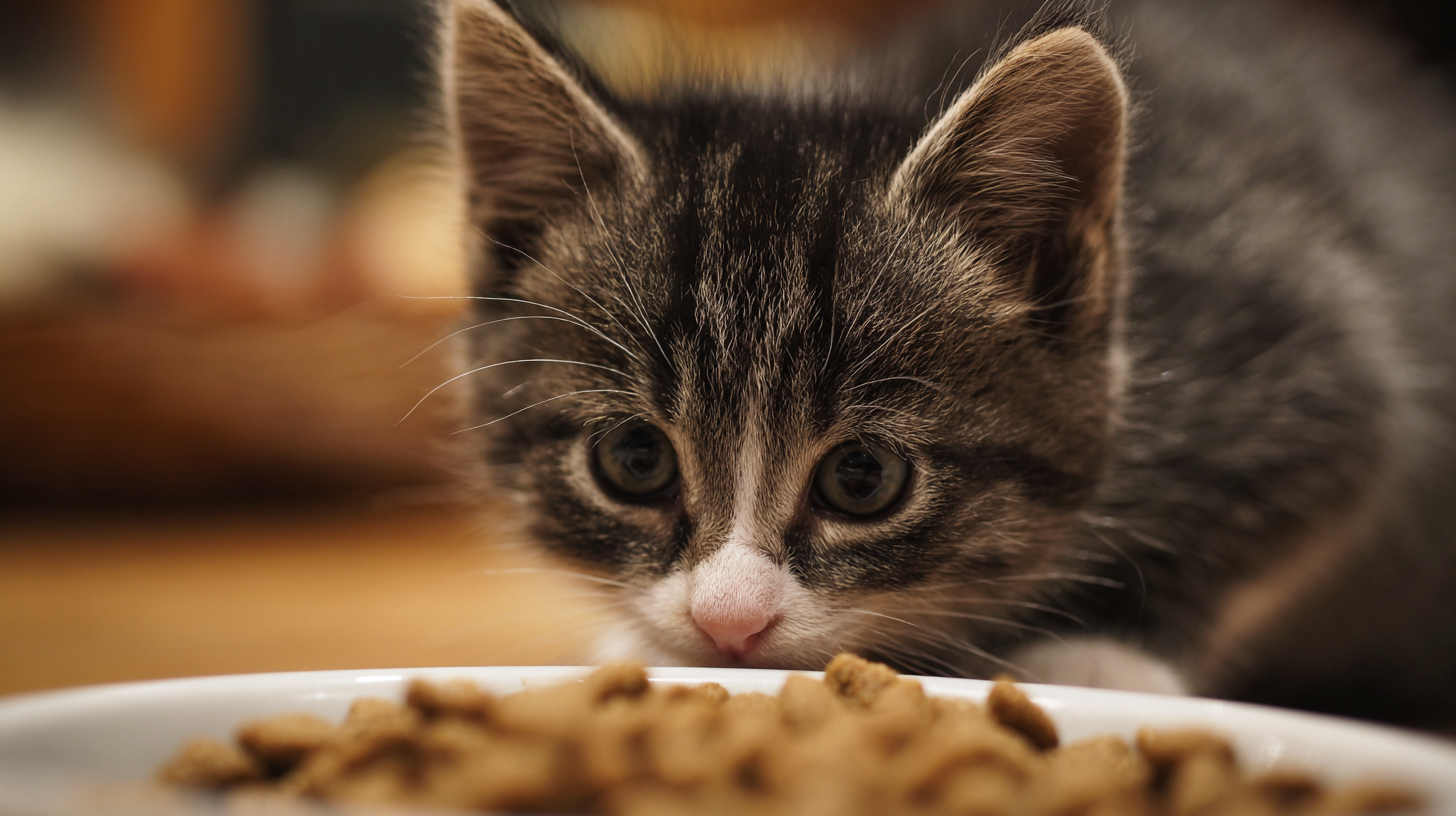 Choosing the right wet cat food for your growing kittens is crucial for their health and development. With so many options available on the market, it can be overwhelming for new pet owners to make an informed decision.
Kittens have unique dietary needs that differ significantly from adult cats, requiring a diet rich in essential nutrients to support their rapid growth and playfulness.
In this ultimate guide, we will explore the key factors to consider when selecting the best wet cat food for kittens, including nutritional content, texture, and flavor preferences.
Whether you're aiming for a high-protein option or seeking sustainable ingredients, understanding these elements will help you provide the best possible nutrition for your furry companions.
Join us as we delve into the top recommendations and solutions tailored specifically for your growing kittens’ needs.
Choosing the right wet cat food for your growing kittens is crucial for their health and development. With so many options available on the market, it can be overwhelming for new pet owners to make an informed decision.
Kittens have unique dietary needs that differ significantly from adult cats, requiring a diet rich in essential nutrients to support their rapid growth and playfulness.
In this ultimate guide, we will explore the key factors to consider when selecting the best wet cat food for kittens, including nutritional content, texture, and flavor preferences.
Whether you're aiming for a high-protein option or seeking sustainable ingredients, understanding these elements will help you provide the best possible nutrition for your furry companions.
Join us as we delve into the top recommendations and solutions tailored specifically for your growing kittens’ needs.
When selecting the best wet cat food for your growing kittens, it's crucial to understand their unique nutritional needs. Kittens have rapid growth rates and require a diet rich in protein and essential fats. High-quality wet cat food should be formulated with a proper balance of nutrients, including animal-based proteins, which support muscle development and energy levels. Look for options that specify real meat as the primary ingredient and contain a mix of vital vitamins and minerals to promote overall health.
Additionally, hydration plays a key role in a kitten's diet, and wet food can significantly contribute to their daily water intake. This is particularly important as proper hydration supports kidney function and aids in digestion. When assessing wet cat food options, pay attention to the fat content, too; it should be sufficiently high to support the energy needs of active kittens while aiding in the absorption of fat-soluble vitamins. Ultimately, choosing a nutritionally balanced wet food will help your kittens thrive as they transition into adulthood.
| Nutritional Component | Recommended Amount (per 100g) | Benefits for Kittens |
|---|---|---|
| Protein | 10-12g | Supports growth and muscle development |
| Fat | 5-8g | Provides energy and aids in nutrient absorption |
| Fiber | 1-3g | Promotes healthy digestion |
| Moisture | 75-80% | Keeps kittens hydrated |
| Taurine | 0.1-0.2g | Essential for heart and eye health |
| Vitamins (A, D, E) | Varies | Supports immune function and overall health |
When choosing wet cat food for your growing kittens, it’s essential to focus on the key ingredients that support their health and development. According to the Association of American Feed Control Officials (AAFCO), high-quality kitten food should contain at least 30% protein to facilitate proper growth and energy levels. Look for real meat, such as chicken or salmon, listed as the first ingredient, as this ensures that your kittens are receiving essential amino acids for muscle development.
In addition to protein, healthy fats are crucial for energy and coat health. Omega-3 and Omega-6 fatty acids promote brain development and help maintain a shiny coat. A report from the Pet Food Institute indicates that kittens fed diets enriched with these fatty acids showed improved cognitive functions and overall wellbeing. Furthermore, don’t overlook the importance of moisture content in wet food, as hydration is vital for the urinary tract health of growing cats. The ideal wet cat food should consist of at least 70% moisture, which encourages water intake and prevents dehydration. By prioritizing these key ingredients, you can ensure that your kittens receive a balanced diet crucial for their early stages of life.

When choosing wet cat food for your growing kittens, grain-free options can provide several vital benefits. Kittens have unique nutritional needs, and their digestive systems are not yet fully developed. Grain-free wet cat food is typically higher in protein and moisture, which aligns perfectly with a kitten's needs for energy and hydration. This type of food mimics their natural diet, allowing them to thrive on the essential nutrients they require for optimal growth.
In addition to supporting healthy development, grain-free wet food can also reduce the risk of common allergies and sensitivities. Many kittens can be prone to grain allergies that manifest in various ways, including digestive upset or skin issues. By opting for grain-free ingredients, you not only avoid potential irritants but also ensure that your kittens are getting high-quality protein sources as their primary diet. This approach can lead to healthier coats, improved digestion, and overall well-being, setting your kittens on the right path as they grow.
When selecting the best wet cat food for your growing kittens, it’s crucial to evaluate the nutritional content and focus on brands recognized for their high-quality ingredients. According to recent industry reports, wet cat food is essential for hydration and provides necessary nutrients for optimal growth. Look for options that include animal proteins, healthy fats, and essential vitamins and minerals, as these components are vital for your kitten's development.

Tips: Always check the first few ingredients on the label; they should predominantly feature meats or meat meals, which are crucial for muscle development. Additionally, consider varieties that are specifically formulated for kittens as they contain a higher calorie density, which supports their rapid growth stages.
Another important factor is the moisture content. Kittens can be prone to urinary issues if they do not consume enough water, so wet food is a great way to help them stay hydrated. Studies indicate that kittens fed wet food are less likely to experience hydration-related health problems.
Tips: Introduce new wet food gradually to avoid digestive upset and encourage your kitten to explore different flavors and textures. Regular veterinary check-ups can provide personalized feeding advice tailored to your kitten's unique needs.
Introducing new wet cat food to your growing kittens can be an exciting yet challenging experience. Kittens have sensitive stomachs and can be particular about their food, so it’s essential to introduce changes gradually. Start by mixing a small amount of the new wet food with their current diet. A ratio of 75% familiar food to 25% new food is recommended for the first few days. This approach allows your kittens to acclimate to the new flavors and textures without overwhelming their digestive systems.
Another useful tip is to monitor their reactions closely. Kittens may show preferences for certain flavors or brands, and it's important to observe their eating habits. If you notice any adverse reactions, such as vomiting or diarrhea, it may be necessary to slow down the introduction process or reconsider your choice of wet food. Providing a stress-free environment during mealtime, such as minimizing distractions and creating a comfortable feeding space, can also encourage your kittens to try the new food enthusiastically.
Lastly, consistency is key. Keep mealtime schedules regular to help kittens associate specific times with eating. If they see you consistently offering the new wet food, they’re more likely to be adventurous and give it a go. With a bit of patience and the right strategies, you can successfully transition your kittens to their new wet food while ensuring they enjoy the process.
